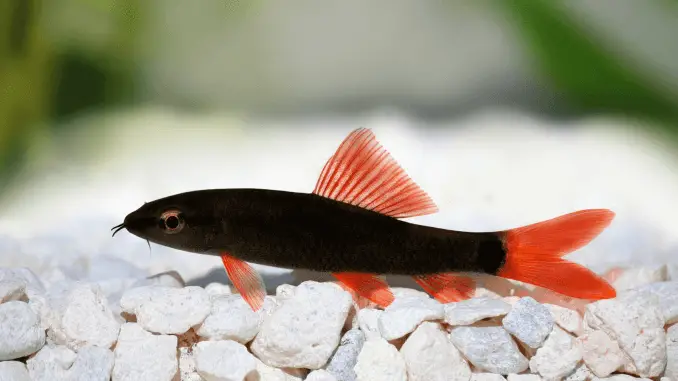
The rainbow shark is a freshwater fish of the Cyprinidae family. Despite its name, this species isn’t a true shark — it’s so-called because of its shark-like appearance.
Rainbow sharks have gray, black, or dark blue bodies with vibrant red or orange fins. The fish are popular due to their unique appearance, but they have higher care needs than other aquarium fish and can be territorial.
TABLE OF CONTENTS
Rainbow Shark Facts & Overview
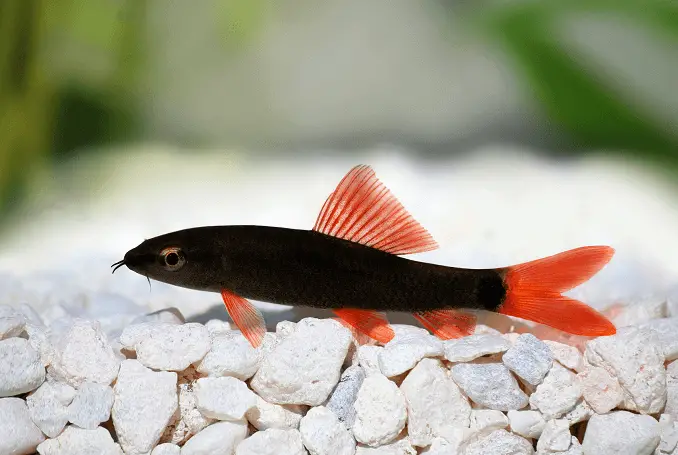
| Scientific name: | Epalzeorhynchos frenatum |
| Common names | Rainbow shark, red-fin shark, red-finned shark, ruby shark, rainbow, green fringelip labeo, whitefin shark, sharkminnow, and whitetail sharkminnow |
| Distribution: | Cambodia, Laos, Myanmar, Thailand, and Vietnam |
| Size: | 4–6 inches |
| Life expectancy: | 5–8 years |
| Color: | Gray, black, or dark blue, with red or orange fins |
| Diet: | Omnivore |
| Temperament: | Semi-aggressive |
| Minimum tank size: | 50 gallons |
| Temperature: | 72–79°F (22–26°C) |
| pH: | 6.5–7.5 pH |
| Hardness: | 5–11 dGH |
| Care level: | Moderate |
| Breeding: | Egg-scatterer |
Origin
Rainbow sharks are native to several major rivers in Southeast Asia, including the Mekong, the Xe Bangfai, and the Chao Phraya. The fish live near sandy river bottoms where plankton and algae are plentiful.
During the monsoon season, they migrate upstream with the high floodwaters and retreat back to lower river sections when the floods dry up.
Even though these fish are common in the wild, they are solitary, territorial fish that avoid one another’s company and spend much of their lives alone.
Rainbow Shark Size & Lifespan
Full-grown rainbow sharks grow up to six inches in length in the wild, and four inches in captivity. The average purchase size is a lot smaller — usually around two inches — and many fishkeepers don’t realize how large these fish will get.
Females are wider in the mid-section than males. The two sexes are not distinguishable by length.
In the wild, rainbow sharks live up to eight years. In captivity, with excellent care, they can live up to six years.
Availability
Rainbow sharks aren’t as common as some aquarium fish, but many pet stores and most online stores sell at least one species. Because this fish is less popular than others, it isn’t always in stock on all websites.
The cost of a rainbow shark is about $5. They prefer to be the only fish of their kind in the tank, so buying just one is recommended.
The following online stores sell common and albino varieties:
Appearance & Behavior
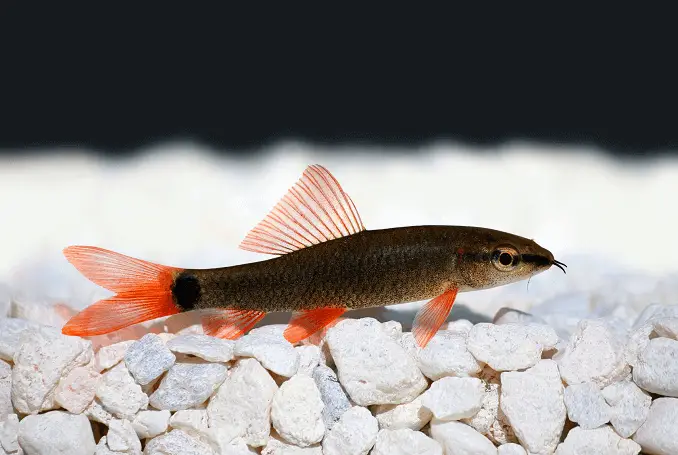
Rainbow sharks have shark-like elongated bodies, flat bellies, and blue or gray coloration. In captivity, they’re semi-aggressive.
Colors, Patterns, Fins, and Sex Differences
The rainbow shark’s body is either black, blue, or gray, with vibrant red or orange fins and a red or orange tail.
It has a pointed snout and a long, flat stomach, with a shark-like upright dorsal fin. The dorsal fins have up to 11 branched rays, and the tail is forked.
Males are thinner than females and develop black lines on their tail fins when sexually mature. Females are paler than males. Stressed or diseased fish are dull in color.
A common color variation is the albino rainbow shark. Albino rainbow sharks have the same red or orange tails and fins as other species, but with white, almost-translucent bodies, and red eyes.
Typical Behavior
In the wild, rainbow sharks are passive and don’t bully or bother other fish. However, in captivity, they have aggressive and territorial tendencies, especially if there isn’t enough room in the tank.
Adults swim quickly around the bottom of the tank and are most active at night.
Juveniles are timid and spend a lot of time hiding. Mature fish their dominance by biting, chasing, and head- and tail-butting other bottom-dwelling fish.
Rainbow Shark Care & Tank Requirements
Rainbow sharks are possible to care for in captivity, but the fish require more care than other freshwater fish. The most important tank requirements are consistent water parameters and plenty of swimming space.
Feed rainbow sharks algae wafers, insect larvae, and aquatic insects.
Habitat and Tank Requirements
The natural habitat of rainbow sharks is warm, freshwater rivers with sandy substrate. You should replicate this environment in the tank with matching water parameters and decorations.
This species requires a large tank of at least 50 gallons, with an aquarium length of at least 48 inches, and a low fish-to-water ratio. The more space you provide to, the less aggressive and territorial the fish are.
Caves, hollowed decor, and plants provide a place to hide, which reduces aggressive tendencies. Java fern, Java moss, and hornwort are good plants for the tank.
Choose a sandy substrate to mimic the sandy riverbed in the fish’s natural environment.
Tank Conditions
The ideal tank conditions for rainbow sharks are:
| Water type: | Soft, well-oxygenated freshwater |
| Tank size: | Minimum 50 gallons, and an extra 50 gallons of water for one extra rainbow shark |
| Water temperature: | 72–79°F |
| Substrate: | Fine sand |
| Tank setup: | Plants, caves, hollow decorations |
| Acidity: | 6.5–7.5 pH |
| Water hardness: | 5–11 dGH |
| Filter: | Yes, to mimic the fast-flowing water of the rainbow shark's natural habitat |
| Bubbler: | Yes, to oxygenate the water |
| Lighting: | Yes, LED tank lighting provides natural day/night cycles, but no special lighting is needed |
| Water heater: | Yes, to maintain consistent, warm water temperatures |
These fish requires consistent water parameters to thrive in their environment, and consistent pH is particularly important to avoid stressing the fish or causing disease.
Disease
There are several diseases that rainbow sharks are prone to in captivity:
Ich
Ich is a parasitic disease that causes white, salt-like spots on the affected fish’s body. Symptoms of ich include flashing (when the fish rubs its body against rough surfaces), lethargy, and loss of appetite. Poor water conditions are usually the cause of ich in rainbow sharks.
Treat ich by quarantining the fish in a separate tank and adding one tablespoon of salt per five gallons of water. Increase the temperature by two degrees to speed up the life cycle of the parasite.
Swim Bladder Disease
Swim bladder disease, or swim bladder disorder, causes the affected fish to sink to the bottom of the aquarium or swim nose-down, tail-up. The disease is caused by constipation or intestinal parasites and can be remedied by feeding the fish green peas.
More serious cases of swim bladder disease require surgery.
Tank Mates
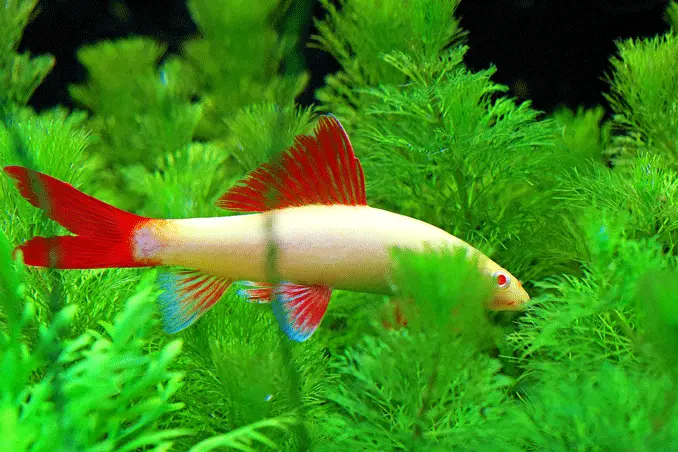
Rainbow sharks are suitable tank mates for peaceful fish that swim in the top sections of the aquarium, as long as there is plenty of room for the fish to have their own space.
You can house more than one of the species if you have at least 100 gallons of tank space, but keeping them alone is recommended in order to prevent stress and hostility.
Don’t house this species with shy fish, like the marbled hatchet fish and otocinclus catfish, which find the rainbow shark’s aggressive nature overwhelming.
Great tank mates that are calm and strong enough to defend themselves against a rainbow shark’s aggression are:
Place the rainbow shark in the aquarium after its tank mates to prevent it from trying to assert the entire tank as its own.
Diet and Feeding
Rainbow sharks are omnivores that enjoy a diet of meat and plants. In the wild, they eat algae, zooplankton, insect larvae, decaying plant matter, insects, and crustaceans. You should replicate this varied diet in the tank, ensuring the fish is supplied with the nutrients it needs to thrive.
These fish aren’t picky eaters. You can feed them a variety of foods that sink to the bottom of the tank, like algae tablets, insect larvae, and zooplankton.
Live crustaceans are a nutritious food that gives the fish the opportunity to catch and eat its prey. Vegetables like spinach, peas, lettuce, and zucchini are good plant-based alternatives to algae.
To retain bold coloring and encourage healthy growth, feed your fish high-protein foods, such as brine shrimp or bloodworms. You can feed these foods in live or frozen forms.
Feed three times per day. Provide enough food for thefish to eat in five minutes, and discard leftover food to keep the tank clean.
Breeding
Wild rainbow sharks reach sexual maturity when they have exceeded four inches in length, and they mate in the months of October and November.
Breeding in captivity is challenging because of territorial, aggressive behavior in confined spaces. Very few people manage to breed this species successfully, and there’s a high chance that the fish will attack, injure, and kill one another.
How to Breed Rainbow Sharks
If you want to attempt to breed rainbow sharks, proceed with caution — and follow these steps:
- Establish a separate breeding tank. The tank should be at least 75 gallons and should contain freshwater and an aquarium-grade gravel substrate.
- Add liquid dechlorinator to the water as recommended on the bottle, and add a filter and water heater. Decorate the tank with rocks, caves, and plants to provide shelters where fish can hide from one another.
- Place the male and female in the tank. Wait for one week to see if they tolerate one another. Remove one of the fish immediately if the pair begins to fight.
- If the fish haven’t attacked one another within the first week, stimulate breeding by feeding the fish high-protein foods like brine shrimp, and by changing 25% of the tank’s water daily using a bucket.
- Continue to provide high-protein foods and change the water daily for another week. If your breeding attempts are successful, the male and female will rub against one another and the female will scatter eggs on the substrate.
- The male will fertilize the eggs within the same day by spraying milt (a fluid containing sperm) onto the eggs.
- Transfer the eggs to a separate fry tank using a fish net. The fry tank should be 10 gallons in size and should contain a mini heater and an air stone attached to an air pump to circulate water.
- After two days, the eggs will hatch and the fry will feed off the egg sacks for another two to three days.
- Once the fry’s yolk sacks have been depleted, feed the fry liquid fry food for up to two weeks, then feed the fry baby brine shrimp. Once the fry have reached one inch in length, move them to their own separate tanks and feed them adult fish food.
Should You Get a Rainbow Shark for Your Aquarium?
Because of the rainbow shark’s territorial behavior, you shouldn’t get this fish unless you have a large enough tank and peaceful — but not shy — tank mates.
Don’t buy one if you’re a beginner aquarist looking for a calm, low-maintenance fish for your tank.
They are beautiful, active fish, and are easy to look after when housed with the right tank mates. Aside from the fish’s aggressive tendencies, they are entertaining to watch in the aquarium.
Rainbow Shark FAQs
- How do you tell if a rainbow shark is a boy or girl?
- Why do rainbow sharks hide?
- Can you put a rainbow shark in a 10-gallon tank?
- Can a rainbow shark live in a 20-gallon tank?
- Why is my rainbow shark turning white?
- Do rainbow sharks jump out of the tank?
- Can you keep shrimp with rainbow sharks?
- Can you keep a rainbow shark with a betta?
- Can two rainbow sharks live together?
- Are rainbow sharks rare?
- Can you keep rainbow sharks with guppies?
- Can a rainbow shark live with neon tetras?
- How many rainbow sharks can live together?
- Are rainbow sharks aggressive?
- What can live with a rainbow shark?
- Can rainbow sharks eat other fish?

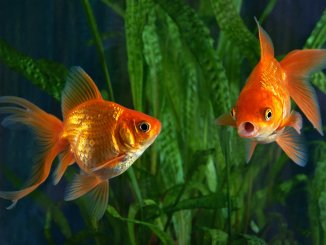
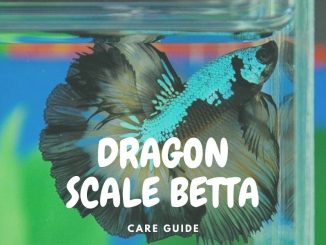
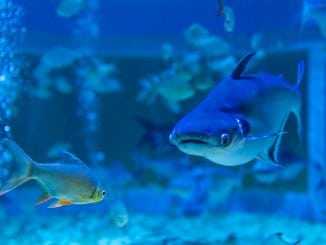
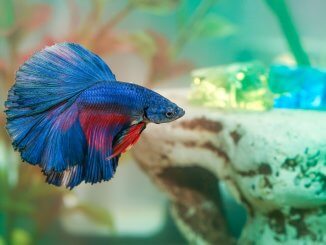
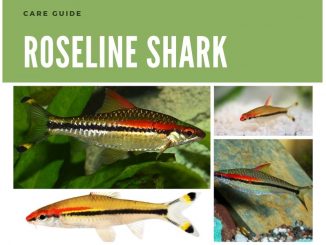
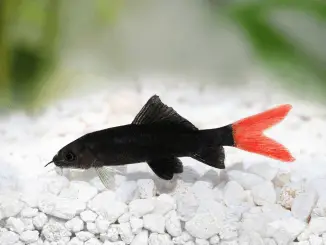
Hi i have a rainbow shark and an albino who have been doing a mating dance for hours never done this before,awesome to watch
Hi Debra,
Sounds amazing, I’d love to see pictures if you’d like to share!
Robert
I have an awesome video of my albino shark and rainbow shark doing the “dance”, I don’t know how I can post the video though on here.
That sounds great Ann! I’d love to see it. Feel free to send it to [email protected]. Thanks, Robert
I have 2 rainbow sharks that have been doing the mating dance and it looks like she might be pregnant in a mixed tank. Any advice would be great
Hi Peggy, how exciting! As you’ll know from our article, they chances of them actually breeding in a home aquarium are slim – just keep an eye on them! Let us know how you get on. Robert
i am extremley new at this…i got a cichlid and a rainbow together…had a little colorful fish but it disapeared???? anyhow the fat cichlid hogs the flakes and was thinking about seperateing them? i have two small tanks maybe one big tank? help me please
HI, I have a rainbow shark and he is now coming up to 14 years old. He shows no sign of slowing down and is still very active. We love him.
Ha Natalie!
So cool to know – you must be very attached to him!
Robert
Hey I just got 2 rainbow sharks 1 normal and one albino which I call custed I didn’t have much room to buy a big tank so I got a 2 foot which I think is 15 gallons in the tank I also have a ghost knife a upside down catfish and a pepper mint bristle nose I also have 2 silver shark and a 80 gallon tank which have a variety of other fish I have noticed my albino rainbow shark chasing my other rainbow shark and my 2 silver sharks nut won’t chase anything else away is there anything I can do with the tank he’s it to get him to calm down?
Do you turn your lights off any make sure they have plenty of down time? Do you also have plenty of hiding places for your fish? Failing this, you could use a tank divider. Robert
I think my sharks have laid eggs.. but I can’t find any pictures to confirm it.. any suggestions on how to find out what they look like?
Hi Carrie, do you have any pictures that I can see to help confirm? Thanks, Robert
Hi Carrie, do you have any pictures for me to take a look at? Thanks, Robert
I’ve had a rainbow shark for about 4 years, who lives alone, I want to Add something to the tank with him that is compatible, any suggestions?
Hi Jeff, you’ll find some suggestions in the tank mate section of this article. Robert
Hi. I just bought 2 rainbow sharks & 2 bala sharks along with 2 sucker fish. They didn’t tell me about any of this. I thought if they come from the same tank then they should be okay but now I’m noticing that 1 of my rainbow sharks are chasing all the other fish in the tank. I’m sure I know the answer but (can I put my rainbow shark in with my beta as that’s the only other tank I have with heat.? If not my next question is (what’s the ideal tank for both species of sharks.? Sand, tank temp, tank size, tank mates etc.?)
I’d advise keeping the Rainbow Sharks and Bala Sharks in different tanks. All the information on tank conditions are listed here in this article for rainbow sharks. Bala Sharks prefer to be kept in schools of at least 6, they are also prone to becoming stressed very easily, so it won’t help their case living with the Rainbow Sharks. Thanks, Robert
I have a 4ft tank that I have managed to cohabit 2 Reeves turtle’s 2 leopard guppies 4 platies and 1 rainbow shark I’m also just about to add a gold nugget pleco so far no fatalities
We just got our son 5 shark fish, 2 rainbow sharks, 2 silver and black sharks and an albino shark. The second to third day the two rainbow ones began their territorial aggression but have since become more laid back. I have noticed that our albino tends to stay to itself. Do we need to add another albino to our tank or is it fine being a “loner”?
Hi Leah, firstly, we only recommend keeping one rainbow shark per tank. As you’ve noticed they can be aggresive towards one another. When you say silver and black shark, do you mean the Bala Shark? Again, we don’t recommend keeping these in the same tank, they’re also aggressive and need much larger tanks(around 150 gallons) You can read more about them here: https://www.fishkeepingworld.com/bala-shark/ Rather than add more sharks, I recommend that you split them up into different tanks. Thanks, Robert
I have a juvenile rainbow shark in a community tank. He has been in there about two weeks . It is 36 gallon tank. Every time I feed the fish he goes bonkers and chases everybody and makes it hard for them to eat. I have three Coreys that he doesn’t bother at all. What can I do?
Hi Richard, unfortunately this is the nature of Rainbow Sharks. They are extremely territorial. Provide your other fish with plenty of rocks and plants to hide in to help him calm down before feeding time. You might want to consider feeding him on his own at one side, them feeding the other fish while he is distracted. Failing this, you could use a divider at feeding time, all through this will be a pain! Eventually you’ll also need a larger tank. Thanks, Robert
I wanted to know if I can add a rainbow shark with my goldfish?
They require different water temperatures so they can’t be kept together for that reason. Thanks, Robert
Hi I recently got a rainbow shark two days ago (thinking I got a red-tailed shark) and just found out today. I noticed that there isn’t really any big differences, but I’m really wondering to how fast they will grow to they’re mature size because he is still a juvenile, but I have him in a 10 gallon tank. How long can he last in there until I get a bigger tank?
Hi Marcus, here is an article on the red tail shark to help you distinguish: https://www.fishkeepingworld.com/red-tail-shark/ They both grow up to around 6 inches and you’ll need to move it into a 50 gallon tank ASAP. They grow quite quickly. Thanks, Robert
can i keep one of these sharks in a tank with no other fish?
Hi Jack, yes you can keep a rainbow shark alone. Thanks, Robert
I have a baby albino rainbow shark in a 30 gallon tank with 2 Molly a silver dollar and an Australian rainbow fish. Do You have any advice on how to raise him?
Hi Jacob, feel free to read our care guides on Mollies and Silver Dollars here: https://www.fishkeepingworld.com/molly-fish/ and https://www.fishkeepingworld.com/silver-dollar-fish/ Thanks, Robert
Hey
So my rainbow shark is not aggressive at all. Actually is the most docile fish in my tank. Could that be from luck; or from the order my fish have been added to my tank??
Also,
My roommate just surprised me with 2 new mollies and my rainbow shark seems to have instantly made best buds with them. The Trio literally go everywhere And do everything together. Even share the same hiding spot. Is this odd? Or something I should keep my eye on? I have multiple tanks so moving the mollies won’t be an issue if needed.
Tank size :80 gallons.
Community: 4 angelfish (4years in tank),1 Kribensis Cichlid (2 years in tank) 1 Rainbow shark(7 months in tank) and the 2 brand new mollies (2 weeks in tank).
Hi Jade, it definitely sounds like just good luck! Keep at eye on them as they grown and separate if you see any signs of aggression. Thanks, Robert
Hi Jade I have an albino rainbow shark too and he is also totally docile and always has been.
I got a rainbow shark he is fairly very active. He acclimated well presenting little to no stress. He’s in a 30 gallon tank and has started kicking up sand. I was wondering if this is normal?
Hi Courtney, is he rubbing himself on the sand or just flicking it around? I’d say if he is rubbing himself on it he might have some sort of infection. If he seems otherwise happy though, just keep an eye on this behavior. Thanks, Robert
Hi Robert, love the article. I have a 65 gallon tank with about 11 fish. The rainbow shark only chases the tri-color shark which is much bigger than him and mostly at feeding time. I assume it is the same reason as why they chase the bala sharks? The two species (bala and tri-color) are very close in appearance. Probably going to move one of them out, just wondering if this is something you see normally?
Hi Pat, yes you’re right and it’s probably wise to move one of them out! All the best, Robert
So my daughter was gifted a 4 gallon tank and an albino rainbow fish for her birthday. Now I see this is way too small- was approved by the pet store and they trusted that info. So he’s been living here for two weeks he mostly hides, what can I do? Should I take him back to the pet store? I’m not sure I’m up for keeping a 50 gallon tank.
Hi Regan, unfortunately most pet store employees simply aren’t trained well enough to understand the care needs of each species. A 4 gallon tank is too small for any fish let alone a fish of this size. If you aren’t able to buy a larger tank, I would return the fish to the store. Thanks, Robert
I have one rainbow shark along with 3 guppies, one molly, 2 skirted tetras and one red eyed tetra. The shark is about 3 inches long and for the last 3 days has stayed continuously behind thew filter, hanging upside down. I’ve had it for about 5 weeks. Is this hiding normal, and should I be concerned? The tank is a 40 gallon.
Hi Jeffrey, do you have plenty of other hiding places for him? These fish are quite territorial and need their own territories. Juveniles are usually very timid and like to hide away so the behavior is quite normal. Thanks, Robert
Hi
I have 2 rainbow sharks.Is there any problem with them?Any guidance because this is first time I’m buying rainbow sharks
Hi Nila, please take a read through this article for guidance. You should only keep one of these fish per tank. Thanks, Robert
Why is my rainbowshark is belly up but not dead? And I have just two sharks.
Hi Nila, it could have swim bladder disease, if after research you think this sounds likely, you can increase the tank temperature and fast him for three days. You should only house one of these fish per tank. Thanks, Robert
I’ve recently got 5 rainbows, 3 normal and 2 albino. All are quite large. I can tell that I have 1 male and 2 female with the normal, but how do you tell the sex of the albinos? I’m guessing they don’t get black stripes on their fins!
Hi Amanda, females tend to be larger and more round than the males. Also ensure that you have a large enough tank for a group of this size (minimum 125 gallons). Many thanks, Robert
Hi, I love this fish & want them in my 3 ft tank it has driftwoods in it but currently i own 6″ tiger oscar. I want to know will they live with oscar?
Hi Vivek, it really depends on the individual behavior of the fish. I would recommend housing them together with caution. Some can get on fine, whereas others will be aggressive towards each other. Thanks, Robert
Anyone ever keep keep a rainbow in an out door pond in SoCal? I want him to have more swimming space. But the pond is not heated. He is about 4 years old now in my 30gal.
Hi can rainbow sharks live past 8 years old? I have a male who is coming up on 8 years old he’s about 5 1/2 inches and I’ve become quite attached to him just wondering how much longer I might have with him?
My shark keeps. Logging up side my tank and it has a spot on its side i just hope he or she isn’t sick
Hi my name is Dean,
I recently acquired three rainbow sharks, one silver shark, and fifteen tiger barbs, and put them in a 55 gallon aquarium. The tank has no substrate, several rock caves that are open, other rocks, and mussel shells. The fish are not large, and now I have read your articles.
The fish are interesting, I like watching them, and they like watching me. Although, the rainbow sharks have started hiding more, except at feeding time. I am hoping for the best. I belong to a fish club and suppose I may have to pull somebody out if they get too rough. I’m telling them to get along, and spending time with them seams to help.
Thank you for sharing information!
– Dean
We have an albino rainbow shark (junvenial) in our 65 Gallon tank, which is now about 5 weeks old. Our shark is cute and has been protecting food pellets from the other fish by chasing them away to allow my other bottom feeders to eat (very cute)! We have been waiting to add some alge eaters to our tank and now we can so we bought 3 otos, which the shark doesn’t bother, however the shark seems to go after our 2 new panda gara which is a little bit bigger then him. I’m not sure if the shark is just upset with some new fish being added the tank that has made him more agitated or just being overly territorial. He started going after other wish which is out of the norm from what we have seen. We have removed him into a bucket (heater and air being used, we don’t have a second tank at the moment) to allow the other fish to feel at home and have also shut off the lights and covered the tank for over 12 hours. We really love this guy, what can we do? Any advice would be great. Do we return him, re-introduce him tomorrow, do we return him and get a baby one?
I have a question, How do you know if The rainbow shark is eating?
Hi, I just bought a new rainbow shark and noticed he had a weird bump near his tail fin, forgive the weird description but it looks like what the dolphin had in the movie dolphin tail, his rear fin is also quite pail and the bottom rear fin is sort of half cut, is this dangerous. I also have an albino and another rainbow shark in the tank
Hello I don’t know if this webpage is still very active or not, but I was hoping to get an albino Rainbow Shark in the near future, I know I need a bigger tank than what I have now (15 gallons). My question is – what would the I guess smallest/cheapest tank size for one Rainbow Shark be? And how big of a tank would I need if I wanted to add a Pleco to that tank? (Or would a Pleco and a Rainbow Shark not be compatible?)
hi, I have a 1,200 gallon tank with a school of Tiger Barbs in it.. there’s almost 40 of them. They killed at 2 small pleco that I placed in the tank for cleaning algae. The tank has white sand and living plants.
Today I placed a Rainbow Shark with them for cleaning duties on the bottom. Surprisingly they allow the Rainbow Shark to swim with them in the school. Is this a sign that everything will be ok? Or would the Tiger Barbs also try to kill the shark like what they did with the plecos?
I have an albino rainbow shark his (I say his I have no idea if male or female) name is “Sharky” I bought him as a juvenile about 8 years and still seems active and healthy He has lived in several tanks from a huge six footer to my downsized 200 litre tank. He currently lives with two Cory cats, three fully grown angels, two gouramis, three green barbs and three red barbs. He occasionally chases the Cory cats but they have lived with him for five years and don’t seem fussed by him. In actual fact it’s one of the three year old gourami that is nutty Sharky is totally chilled and has always been the only shark in my tank. When I had a six foot set up he even lived happily with two fully grown oscars who were the calmest non bullying oscars I’ve ever seen.
Oops should have read 8 years ago
Hi Robert!
I may have an anomaly (or 2) to your article. I respect your experience, education, and practical knowledge and in no way intend to discredit this well-written article. I do have 2 rainbow sharks living in the same tank since 2000. YES!, December of 2000. I purchased these fish for my children as a Christmas gift. This year they are 20 years old!! Now I wish I would have kept proof of purchase… lol. These 2 fish are unbelievable! 3 tanks, an acre of live plants (exaggerated), and a community of fish later… They decided they need their own tank. They seem very happy at 6 and 9 inches in length and have eaten the same flake food, without variation (other than the fish and plants early on), for 20 years. I just wanted to weigh in with what some might consider statistical outliers. I have no idea what I did right, or wrong, or even if I had any influence over their longevity at all. I do know they must be happy!
Hi I think I have a pair of albino rainbow sharks that have spawned but I’m not sure because I am new to the hobby
Very interesting read, love the nature of these guys. I learnt not to keep 2 together by keeping 2 many years ago after the shop didn’t say not to. Relentless at scrapping, one got seperated eventually! Got one now who’s a big 3 year old female and she loves deliberately throwing her weight about sometimes, definitely boss woman in there! My other guys are used to her and just swim out the way if she’s on one and she particularly loves chilling with my giant African shrimp in the caves.. though she’s picked the smallest cave that’s half her length to claim as her own and has done since she was tiny!
i am extremley new at this…i got a cichlid and a rainbow together…had a little colorful fish but it disapeared???? anyhow the fat cichlid hogs the flakes and was thinking about seperateing them? i have two small tanks maybe one big tank? help me please